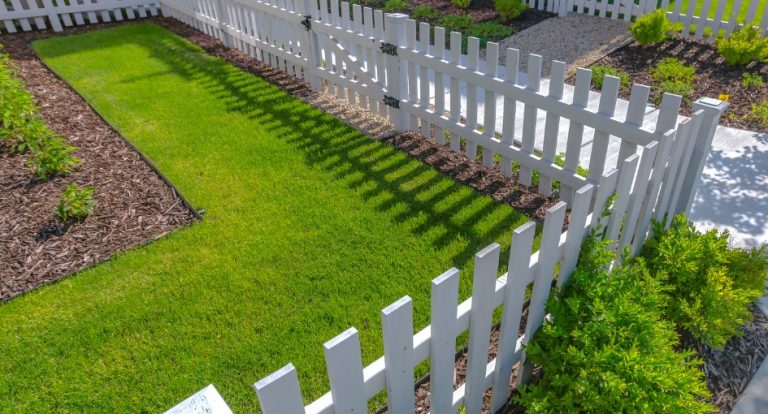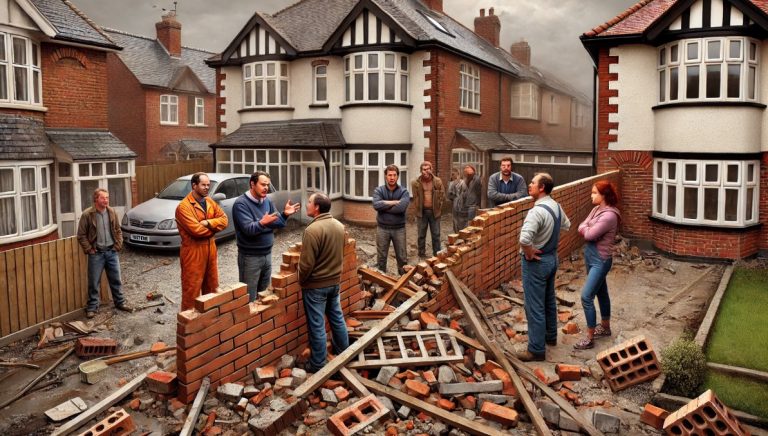In the UK, building near or on a boundary line is a subject surrounded by strict regulations. Whether you’re constructing an extension, a garden office, or a shed, it’s crucial to be aware of these rules.
Building within 1 metre of the boundary introduces several concerns, such as planning permission, fire safety, and neighbour relations. Failing to comply with these regulations can lead to legal consequences, including the potential for fines or even the need to dismantle the structure.
This guide will walk you through the essential regulations, rules, and key considerations you must keep in mind when planning to build near your property boundary. Let’s dive into the specific requirements that ensure your project stays compliant while maintaining good relations with your neighbours.
Understanding UK Building Regulations
Building regulations in the UK ensure that any construction adheres to safety, energy efficiency, and accessibility standards. These regulations cover various aspects of construction, including fire safety, ventilation, and structural integrity. If you are considering building close to the boundary of your property, it is crucial to first understand how these rules apply to your situation.
Key areas covered by UK building regulations
- Structural stability: Ensuring the building remains safe under load and environmental pressures.
- Fire safety: Special requirements for buildings close to the boundary to prevent fire hazards.
- Thermal efficiency: Regulations for insulation and energy consumption, especially important for permanent structures.
- Ventilation and drainage: Making sure buildings have adequate airflow and water drainage to prevent long-term issues.
For buildings that don’t require planning permission, it’s still necessary to check building regulations. The need to comply with these rules will depend on factors like the height of the building, its intended use, and how close it is to the boundary.
Can I Build Within 1 Metre of Boundary?
The question of whether you can build within 1 metre of the boundary largely depends on the type of building and its purpose. Smaller, non-permanent structures like sheds or garden offices can often be built within this proximity without significant issues, provided they don’t exceed height restrictions or infringe on your neighbour’s rights.
When planning to build near a boundary, several key considerations come into play:
- Building height: For garden buildings, if the height of the eaves is under 2.5 metres, you may not require planning permission even if it’s close to the boundary.
- Fire safety requirements: For buildings close to boundaries, non-combustible materials are often a requirement.
- Rights to light: If your building obstructs light to your neighbour’s property, they may have grounds to challenge your construction, even if it’s within your boundary.
Generally, the building within 1 metre of boundary UK rule allows for certain exceptions, especially for garden buildings, but you must consult local authorities to determine if your project falls under permitted development rights or if you need additional permissions.
Planning Permission for Building Close to a Boundary
For many smaller structures, planning permission is not always required, thanks to permitted development rights. However, if your construction is tall, particularly close to the boundary, or if it alters the character of your property or your neighbours’, you may need planning permission. Buildings with construction near property lines could potentially infringe on your neighbour’s privacy, light, or enjoyment of their property, triggering the need for formal approval.
Planning permission is typically required in the following cases:
- Multi-storey extensions: Even if the extension is within the permissible height limits, multi-storey buildings often require planning permission when built near a boundary.
- Protected areas: In conservation areas, national parks, or properties that are listed, the rules are often stricter.
- Impact on neighbours: If your project involves digging close to the boundary, building tall structures, or otherwise affecting your neighbour’s property, the local planning authority may require you to seek planning permission, especially if your neighbour objects.
Additionally, it’s important to note that breaching planning permission rules can result in being ordered to remove or alter the structure, so always ensure compliance before beginning work.
Fire Safety and Structural Considerations
Building close to a boundary, especially within 1 metre, introduces significant fire safety concerns. According to UK building regulations, any structure near a boundary must be designed to prevent the spread of fire between properties. This is especially crucial in densely populated areas where a fire could easily jump from one building to another.
Key fire safety requirements include:
- Non-combustible materials: When building within 1 metre of a boundary, UK law mandates the use of non-combustible materials for walls, roofs, and other structural elements to reduce the risk of fire spreading.
- Windows and doors: Openings, like windows and doors, are generally not allowed on walls that are less than 1 metre from the boundary. This is to limit the risk of fire spreading to or from neighbouring properties.
- Fire-resistant cladding: If the building is too close to the boundary, it may be required to have fire-resistant cladding, depending on the size and purpose of the structure.
In terms of structural stability, the proximity to a boundary means that the building must withstand environmental pressures like wind loads, which can be stronger near property lines, particularly in exposed areas. This is especially important for garden buildings or larger extensions.
Garden Buildings and Sheds
If you are constructing a garden building within 1 metre of the boundary, you are generally allowed to do so under permitted development rights—as long as the building meets certain conditions. Sheds, garden offices, and other small structures are usually not subject to stringent regulations unless they exceed specific size and height limits.
Some key factors to consider when building a shed within 1 metre of the boundary:
- Height restrictions: The building must not exceed a height of 2.5 metres at the eaves if it’s within 1 metre of the boundary.
- Usage: If the building is used as a habitable space (like a garden office), it may be subject to stricter regulations.
- Foundation and drainage: Proper drainage is required to prevent water from flowing onto your neighbour’s property, and a strong foundation ensures stability, especially for permanent garden structures.
While sheds and small outbuildings are generally exempt from planning permission, it’s important to ensure that they are built with high-quality materials to meet safety standards.
How Close Can I Build to My Neighbour’s Boundary?
The proximity to a neighbour’s boundary can raise various legal and practical concerns. The UK law surrounding how close can I build to my neighbour’s boundary UK suggests that you can usually build as close as you like, as long as the building adheres to height restrictions and building regulations. However, it’s always advised to communicate with your neighbours before starting construction, as disputes can arise over issues like sunlight blocking or loss of privacy.
In some cases, your neighbour may have the legal right to object to your construction, particularly if:
- Your building will block natural light to their windows.
- The new structure may reduce their privacy by allowing views into their property.
- There is a risk of damage to their property, especially during the construction process.
One common solution is to ensure the building meets the Party Wall Act requirements if any part of your construction work will impact a shared boundary wall or excavations near the boundary.
Minimum Building Distance from Boundary
The minimum building distance from the boundary for most projects in the UK is 1 metre, though this can vary depending on local regulations and the type of structure. In urban settings, where space is more limited, stricter guidelines may be in place, requiring more distance from neighbouring properties.
For rural areas, the rules can be more relaxed, but it’s always important to verify this with your local council before starting construction. If the building is intended for living purposes, such as a garden office or a guest room, additional rules about access, privacy, and fire safety may apply.
Consequences of Non-Compliance
Building without regard to UK planning regulations and boundary rules can have significant consequences. Non-compliance with these laws may result in:
- Legal action: Your neighbours could file a complaint, potentially leading to a court case if your building negatively impacts their property.
- Enforcement notices: Local authorities can issue enforcement notices requiring you to make alterations or even demolish the building if it breaches planning permission or building regulations.
- Fines: In some cases, fines can be levied for non-compliant buildings.
The best approach is to consult with local authorities before beginning your project, adhere to regulations, and maintain open communication with your neighbours throughout the process.
Conclusion
Building close to a boundary can be a great way to maximise space on your property, but it comes with its challenges. Ensuring that you follow all relevant UK building regulations and planning permission requirements is essential. Whether it’s a garden shed, home extension, or any other type of building, adhering to the correct guidelines will prevent costly legal issues and disputes with neighbours.
Always consult with local planning authorities, keep your neighbours informed, and make sure your building meets all necessary fire safety and structural stability requirements. Doing so will make the process smoother and help avoid any potential conflicts.
What Are the FAQs About Building Within 1 Metre of Boundary?
How far should a garden building be from the boundary?
For garden buildings, you can build within 1 metre of the boundary as long as the height doesn’t exceed 2.5 metres and the building adheres to fire safety regulations.
Do I need planning permission to build near a boundary?
Planning permission may be required if your structure exceeds height limits, affects neighbouring properties, or is in a protected area such as a conservation zone.
What are the fire safety concerns when building near a boundary?
Fire safety is a significant concern, particularly when building within 1 metre of a boundary. Buildings must use non-combustible materials, and there may be restrictions on windows and doors.
Can I build a shed within 1 metre of the boundary without permission?
Yes, you can often build a shed within 1 metre of the boundary under permitted development rights, provided it meets height and usage restrictions.
What should I do if my neighbour disputes my boundary construction?
It’s important to communicate with your neighbour before starting construction. If a dispute arises, legal advice may be necessary to resolve the issue amicably.
Is planning permission required for all garden structures?
Not all garden structures require planning permission. Small buildings like sheds typically fall under permitted development, but you should always check local guidelines to ensure compliance.
Are boundary regulations different for sheds compared to other buildings?
Yes, sheds and other small outbuildings have different, often more relaxed, regulations compared to large buildings like extensions. However, fire safety and height restrictions still apply.






